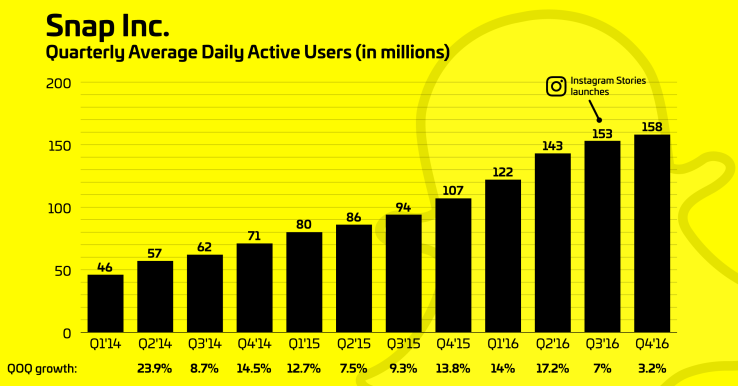Snapchat is having a rough year. A recent earnings report showed user growth was only 5%, and free cash flow was negative $173 million – both down from previous reports.
Ouch.
It gets worse for the company. An NYU Stern professor compared investing in Snap to drunk driving, calling it the most overvalued company in the world. Many advisors have changed their recommendation for Snapchat to “sell,” encouraging investors to drop the stock.
What’s causing investors, users, and advertisers to turn away from Snapchat? Undoubtedly, several factors contribute to Snap’s troubles. But there’s one problem at the core of Snapchat’s declining growth: a lack of user personalization compared to their competitors. This makes Snapchat’s story a warning for companies of all sizes, not just startup unicorns.
Snapchat’s Main Competition Is Winning Because It Delivers Better Ads
Snapchat’s declining growth trend can be traced directly back to Instagram’s launch of Stories. If you’re a Snapchat user, “Stories” probably sounds familiar. That’s because Instagram copied it directly from Snapchat. On both platforms, the Stories feature allows users to post videos and photos for followers. These stories disappear after 24 hours.
Data from both companies suggests Instagram Stories is to blame for Snapchat’s growth decline.

Why would the same feature cause Instagram to grow while slowing Snapchat’s expansion? The difference between apps is the level of personalization when serving ads to users. Snapchat takes a one-size-fits-all approach to its advertising, showing the same ads to broad audiences regardless of personal information. Instagram, however, applies prescriptive big data to select which ads users see.
As data indicates, users love a personalized experience—even if they are ads. Adlucent (via Marketing Dive) reports 71% of customers prefer personalized ads. Conversely, a Hubspot survey showed that 51% of people have a lower opinion of brands that use auto-playing video ads.
With this data in mind, Snapchat’s struggle makes more sense. Snapchat’s ads feature mainly autoplay video with virtually no personalization.
Instagram, on the other hand, leverages big data from its users. It also uses a combination of ads that include pictures and videos (some which autoplay, some which don’t). Then, it delivers a personalized experience to every single one. Every one of Instagram’s 750M daily active users gets a unique experience, provided by big data personalization. As the growth chart shows, users clearly prefer this approach to Snapchat’s.
Brand Personalization is No Longer Optional
It’s astounding Snapchat isn’t working to deliver better personalization for its users, especially since this ability is more cost effective than ever. Gartner says 2017 is the year big data and analytics go mainstream. If your brand isn’t developing a customer personalization strategy, hurry – your competitors probably are.
Still not convinced you need to deliver personalization ASAP?
- 65% of customers are more likely to shop at a retailer who remembers their past purchases or preferences, while 58% are more likely to make a purchase after receiving relevant recommendations (Accenture).
- 69% of customers strongly agree that they find it useful when they see an online ad for products recently viewed on a retailer’s website (Listrak).
- 59% of shoppers experiencing personalization believe it has a noticeable influence on purchasing decision (Infosys).
How to Embrace Personalization
Instagram’s user experience excels for more than offering the right features. It delivers winning eCommerce recommendations based on personal preferences, recent shopping activity, and big data analysis. Customers apparently love personalized brand ads via this third-party platform. How much more would these customers enjoy personalized shopping experiences directly from brands themselves?
Across every industry, and in every stage of the buying cycle, personalization needs to be a core part of your customer experience. Here are some ideas to get started:
- Develop informed customer profiles and learn as much as you can about customer purchasing preferences. Nurturing a brand community allows you to quickly gain these insights from real customers, not “best guess” avatars.
- Allow users to self-select paths through your website, then remember their preferences and deliver tailored messages to them. Test this before, during, and after launching with real users.
- Explore technologies that enable greater customer engagement, deliver more valuable insights, and lay the groundwork to leverage prescriptive big data.
It’s still too early to say whether Snaphat will figure out user personalization or continue declining. But the value of user personalization is clear for all brands. If your brand doesn’t embrace personalization, you can expect users to flock to competitors that do.






